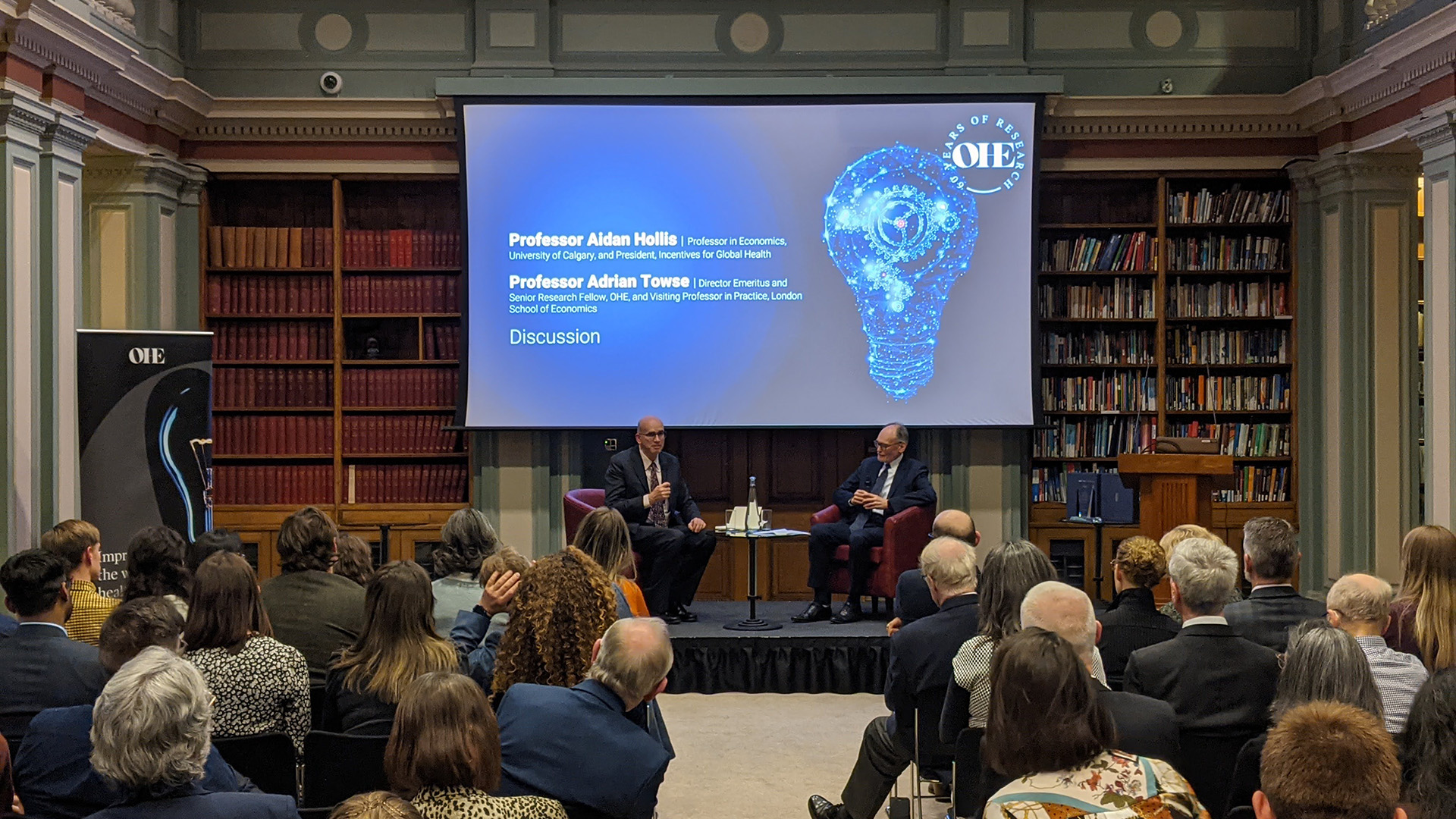Sign up to our newsletter Subscribe
Analysing Global Immunisation Expenditure


2022 question:
“How can policymakers design a system to generate fair prices that balances access and innovation throughout the lifecycle of medicines?”
We are delighted to present the winner and finalists of the OHE Innovation Policy Prize 2022.
Our four finalists have competed to create the most innovative, sustainable, and global solution for our inaugural question ‘How can policymakers design a system to generate fair prices that balances access and innovation throughout the lifecycle of medicines?’
All our finalists have created novel and unique solutions to tackle an important issue. Our ambition for the OHE Policy Prize is that by incentivising new and independent research, we consequently inspire positive change.
Professor Aidan Hollis, Professor at University of Calgary
Overall score: 122
A “fair” price for new pharmaceutical products must meet three objectives: (1) it must be “fair” as between buyer and seller, ensuring especially that poor buyers can afford to meet their health needs while firms’ investments are rewarded appropriately; (2) it must be “fair” as between different sellers, ensuring that the rules for what will be rewarded are clear and not arbitrarily enforced; and (3) it must be “fair” as between countries, so that each makes an appropriate contribution to support the global investment in innovation.
The current systems of pricing pharmaceuticals fail on all three counts. With respect to the first, there is a constant struggle to ensure that prices do not create an insuperable obstacle to access, given that buyers have very different financial capacities. A price that is no barrier to access to an insured patient in France may be unaffordable for patients (and insurers) in Bulgaria. High prices often inhibit access to drugs for rare diseases even in wealthy countries. At the same time, firms often feel that their investments are inadequately compensated. With respect to achieving fairness between different sellers, the current system also fails. The problem is that in most countries, confidential price negotiations… Read full entry.

Alex Bates, Director at GlaxoSmithKline
Overall score: 121
There are a number of characteristic failures in healthcare markets which create problems for regulators trying to design fair systems. This essay concerns what I believe is the biggest barrier to creating a system which balances access and innovation throughout the lifecycle of medicine, information asymmetry. Asymmetric information is when one party to a transaction has better knowledge about the value of the product being bought or sold (for example, how effective a drug might actually be in the real world). This is problematic for the less knowledgeable party, because it means they cannot be sure if they are getting good value for money. In extreme cases of asymmetric information, the healthcare market could collapse because of a breakdown of trust between manufacturers and regulators.
During the course of investigating a drug, a manufacturer will generate significant quantities of ‘latent’ knowledge (facts the manufacturer has reasonable grounds to believe are true but which cannot be systematically proved to regulators). For example, the manufacturer might have reasonable grounds to believe that dose modification could prevent an adverse event, but be prevented by their license from making a claim that this will actually happen. This ‘latent’ knowledge will eventually be converted into… Read full entry.

Mata Charokopou, Head of Global Payer Strategy & Health Economics at UCB
Dr James Zackheim, VP– Head of Corporate Strategy at UCB
Dr Lancelot Henry de Frahan, Post–doctoral researcher at University of Chicago
Overall score: 108.5
The patent system incentivizes innovation by providing temporary market power to innovators so that they can reap a (larger) share of the social surplus of their invention. The pharmaceutical industry is organized around such a system.
The policy arrangement comes at a cost: pricing above marginal cost reduces consumer welfare and generates a temporary deadweight loss on the newly created markets. Since Nordhaus (1969, 1972), there is a well–developed theoretical literature analyzing this tradeoff and deriving formulas for the optimal patent duration. Pharma – in theory – sets the price by trading off the marginal benefits of a price increase with the marginal cost.
We are looking for a policy that would affect the trade–off – at the margin – that Pharma faces when setting its price. The marginal benefit to Pharma of a price increase is, of course, that each drug is sold at a higher price which increases revenue. But there is a marginal cost: lower demand for the drug as the price increases. It is well–known that the ability to set the price without competitors (i.e. market power) theoretically leads the patent–holder to solve this trade–off in a way that results in a price higher than the… Read full entry.
Dr Mike Paulden, Associate Professor at University of Alberta, Canada
Overall score: 108.5
A growing challenge faced by public health care payers around the world is deciding which medicines to approve for reimbursement, and at what price. As higher–cost medicines put increasing pressure on public health care budgets [3], the need to identify ‘fair’ prices for medicines has never been greater. Economic evaluations of medicines form an important component of health technology assessment (HTA) processes [4]. These are increasingly used during negotiations over the prices of new medicines between payers and manufacturers [5]. Conventionally, these economic evaluations involve a comparison of a medicine’s incremental cost–effectiveness ratio (ICER) to a cost–effectiveness ‘threshold’ [6].
The past decade has seen numerous advancements in the theoretical and empirical literature regarding how such a ‘threshold’ should be specified [7–10]. At present, there are two conceptually different approaches, termed ‘demand–side’ and ‘supply–side’; a demand–side approach assumes that the ‘threshold’ should reflect a socially legitimate aggregation of individuals’ willingness–to–pay for a marginal improvement in population health, while a supply–side approach assumes that the ‘threshold’ should reflect the health opportunity cost of reimbursing medicines within a budget constrained health care system (i.e. the health loss experienced by other patients) [11,12].
In practice, reimbursement decisions involve a number of considerations that… Read full entry.


Our team of experts has a broad range of experience across all facets of health economics
Our monthly Bulletin highlights our work alongside the latest from across health economics and health care.